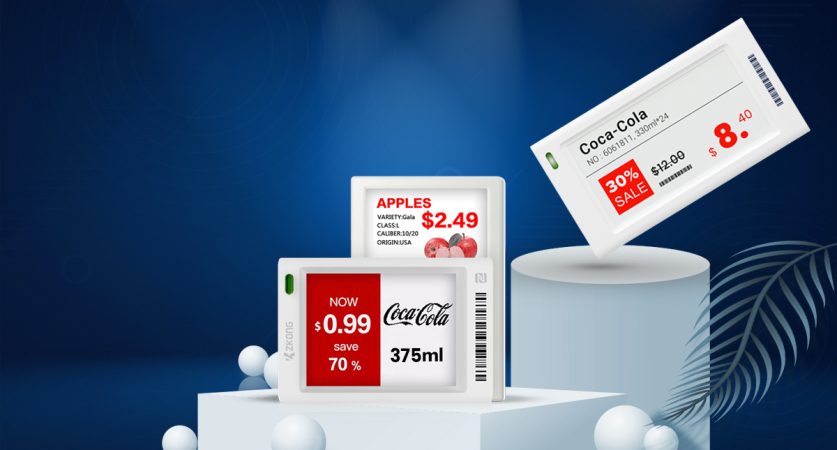Revolutionizing Retail: The Impact and Benefits of Electronic Shelf Labeling (ESL) Systems

In the fast-paced world of retail, staying ahead of the competition is essential. One technology that has revolutionized the retail landscape is Electronic Shelf Labeling (ESL) systems. These innovative shelf labels are transforming traditional retail practices and providing numerous benefits to both retailers and customers. In this article, we will explore the significance of ESL systems, their advantages, and how they are reshaping the future of retail.
Understanding Electronic Shelf Labeling:
Electronic Shelf Labeling, commonly known as ESL, refers to the digital display systems used to replace traditional paper price tags on store shelves. These labels utilize electronic paper (e-paper) or liquid crystal display (LCD) technology to showcase product information, pricing, and promotions. ESL systems are wirelessly connected to a central server, enabling real-time updates and synchronization with the retailer’s pricing and inventory management systems.
The Benefits of ESL Systems:
Efficient Price Management:
ESL systems eliminate the need for manual price tag changes. Retailers can update prices in real-time, ensuring accurate and consistent pricing across all shelves. This efficiency not only saves time but also reduces the risk of pricing errors.
Dynamic Pricing Strategies:
With ESL, retailers can easily implement dynamic pricing strategies. Prices can be adjusted based on factors such as demand, time of day, or promotional events. This flexibility allows retailers to optimize pricing for maximum profitability.
Enhanced Customer Experience:
ESL systems contribute to an enhanced shopping experience for customers. The digital displays provide clear and easily readable information, including product details, pricing, and promotions. This improves overall customer satisfaction and fosters loyalty.
Quick and Centralized Updates:
Traditional paper tags require significant time and effort to update across an entire store. ESL systems enable centralized control, allowing retailers to update product information and pricing instantly across all shelves, ensuring consistency and accuracy.
Real-time Inventory Management:
ESL systems are integrated with inventory management systems, providing real-time updates on product availability. This helps prevent out-of-stock situations and allows customers to make informed purchasing decisions.
Environmental Sustainability:
By eliminating the need for paper tags and constant printing, ESL systems contribute to environmental sustainability. The long battery life of electronic shelf labels further reduces waste, making them an eco-friendly solution.
Increased Operational Efficiency:
ESL systems streamline various operational aspects, from pricing updates to inventory management. This increased efficiency allows retail staff to focus on other essential tasks, leading to a more productive and well-organized retail environment.
Adaptability to Market Trends:
Retail is dynamic, and market trends can change rapidly. ESL systems provide retailers with the agility to adapt quickly to market shifts, whether it involves pricing adjustments, new product launches, or promotional campaigns.
The implementation of ESL systems involves several key steps:
Infrastructure Setup:
Retailers need to establish a robust infrastructure, including the installation of electronic shelf labels and the necessary communication network.
Integration with Existing Systems:
ESL systems must be seamlessly integrated with the retailer’s existing pricing, inventory, and point-of-sale systems. This integration ensures accurate and synchronized data across all platforms.
Training and Adoption:
Retail staff must be trained on using the new ESL systems. This includes understanding how to update prices, manage promotions, and troubleshoot any issues that may arise.
Testing and Quality Assurance:
Before full-scale implementation, thorough testing and quality assurance are essential to identify and address any potential issues. This phase ensures a smooth transition to the new ESL system.
Continuous Monitoring and Updates:
Once implemented, ESL systems require ongoing monitoring and maintenance. Regular updates, both in terms of software and pricing information, are crucial to maximizing the benefits of the system.
The Future of Retail with ESL:
As technology continues to evolve, the future of retail with ESL systems looks promising. Here are some anticipated developments:
Integration with Smart Technologies:
ESL systems are likely to integrate with smart technologies, such as Internet of Things (IoT) devices and artificial intelligence. This integration will further enhance the capabilities of ESL systems, allowing for more personalized and responsive shopping experiences.
Expansion of Interactive Features:
Future ESL systems may include interactive features that allow customers to access additional product information, reviews, and promotions directly from the electronic shelf labels. This interactive element can further engage customers and influence their purchasing decisions.
Increased Use of Data Analytics:
Retailers will leverage the data generated by ESL systems to gain insights into customer behavior, preferences, and buying patterns. This data-driven approach will enable retailers to make informed decisions and tailor their strategies to meet customer demands.
Global Adoption and Standardization:
As ESL systems prove their value, their adoption is likely to become more widespread on a global scale. Standardization of ESL technology and communication protocols may also occur, facilitating interoperability across different retailers and industries.
Conclusion:
Electronic Shelf Labeling systems have emerged as a game-changer in the retail industry, offering a myriad of benefits that contribute to operational efficiency, enhanced customer experiences, and environmental sustainability. The ability to adapt quickly to market trends and implement dynamic pricing strategies positions ESL systems as a vital component of modern retail strategies.
As retailers continue to invest in technology to stay competitive, the widespread adoption of ESL systems is expected to shape the future of retail. The integration of smart technologies, interactive features, and data analytics will further propel ESL systems into becoming an indispensable tool for retailers aiming to provide seamless and innovative shopping experiences. Embracing the electronic transformation of shelf labels is not just a step forward in modernizing retail practices but a leap into the future of a more connected, efficient, and customer-centric retail landscape.
- SHARES
- [shared_counts]

Ashmawi Sami has a Bachelor degree in Travel and Tourism Management from the University of Minnesota. He has his own travel vlogging channel. Besides being a fantastic yoga instructor he has travelled to 9 countries and planning his next trip soon. As the father of 3 dogs, he is well-trained in parenting, crowd control, and crisis situations.
ABOUT ME

Gillian is a freelance blogger, student, and full-time traveler. Each day she spends her time exploring something exciting to help people find the information they need while travelling to a new destination. Whether it be the place to enjoy holidays, or a spot to throw a party or hidden gems that you must visit in the city.
ALL CATEGORIES
- Adventure (13)
- Automotive (8)
- Business (724)
- Education (13)
- Event (4)
- Health (286)
- Insurance (11)
- Lifestyle (12)
- News (1)
- Real Estate (19)
- Shopping (26)
- Technology (23)
- Travel (8)

JOIN US TODAY
POPULAR POST
January 27, 2021 -
Adventure Travel For The Audacious Spirit
January 27, 2021 -
Small Business Loans for Women
January 27, 2021 -
Adventure Tours in Vanuatu
RECENT POST
July 10, 2025 -
Precision Engineered Fasteners: Trusted Manufacturers in India
India has firmly established its recognition as a...
July 10, 2025 -
Premium Super Duplex, Titanium and Copper Nickel Products for Industrial Excellence
As worldwide industries evolve, the call for superior...
July 10, 2025 -
Top copper product manufacturer in India: Quality you can trust
Copper is one of the maximum critical metals...
July 10, 2025 -
Premium Quality Metal Components from Triton Metal & Alloys
Triton Metal & Alloys, a leading metal and...





